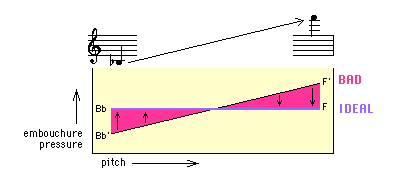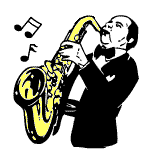(Down - Up - Top)
SAX 9.6 - Tongue shape and Vowels
From its dramatic changes in shape for the various notes you may perhaps conclude that the tongue plays the defining role in oral tract manipulation.
Some teachers and music articles place great emphasis on manipulation of the tongue shape.
The usual method to achieve this is by simulating the various vowel sounds.
However this is only part of the story. As soon as you gain some skill in producing Overtones it becomes very obvious that most of the control of Overtone (pitch) selection comes from the throat and rear part of the mouth rather than the agile part of the tongue.
In all my years of Overtone and Tone practice I can not remember a single instant where I had to think of what to do with my tongue.
My main mental focus is always on the throat. The best tongue position is found through (subconsciously) guidance from the ear.
|  |
You will also notice that the tongue movement can change both the pitch and character (timbre) of the tone.
Here a Table with vowel sounds for the main tongue shapes.
The various positions refer to the apex (uppermost point, not tongue tip) of the tongue shape.
| Tongue Apex | Rear | Centre | Front |
|---|
| High | who'd | about | heed |
| Medium | hawed | learn | head |
| Low | father | but | had |
It can be useful to experiment with the various vowels, especially in the early stages when you are still coming to grips with all the Overtones.
However in general focus your mind and organic imagery on the throat and let the tongue shape be guided (subconsciously) by the ear.
(Down - Up - Top)
SAX 9.7 - Posture
Perhaps the most useful Jazz slang term I know is "cat" (or even better : "cool cat") to describe a Jazz musician.

| If, after all my good advice in Lesson 3, you still end up on stage a little tense and apprehensive : don't worry. Just imagine yourself to be one of these nonchalant, fluidly moving cool cats, ready to pounce, and immediately all the joints in your body (knees, hips, shoulders and elbows) loosen up and you are 100% relaxed and ready for anything.
A great imagery to use, especially when you are tense.
A former teacher of mine describes the required relaxed body state to be just "one point above total collapse."This too is a useful image to bring the body in a relaxed state for a good performance. |
|
If you are interested in improving your posture and getting more effective energy from your body, I recommend the Alexander Technique. The Alexander technique was developed by F.Matthias Alexander
from Tasmania (Australia) about a hundred years ago.
It is used by many professional musicians. The purpose of the Alexander Technique is : - to unlearn the habit patterns that interfere with our overall co-ordination, ease in movement, postural balance and poise
- to release unnecessary tension and to redirect it into useful energy
You can develop this technique by : - reading about it in books by Alexander, by Wilfred Barlow ,or by Edward Maisel
- or following a course by one of the many qualified Alexander Technique Teachers located throughout the world.
|
(Down - Up - Top)
SAX 9.8 - Long Tone Exercises
Long tone Exercises are generally not recommended for beginning students, and I agree with that approach.
Start with these exercises after you have sufficiently developed your embouchure and breathing technique and have made a serious start on Overtone practice. |
Like all the other Tone Exercises in this Course I recommend that you do them each practice session after your Overtone work out.
Rotate Exercises 1 - 5 over a period of time. Spend 1 to 2 weeks on one Tone exercise, then switch to another one.
Both Tone Exercise 4 and Tone Exercise 5 are ideally suitable to apply some of the Organic Imagery techniques explained in this lesson ( "breathing in" - "wire" or "triangle" in the throat).

Tone Exercise 4 (described by Ray Pizzi) is a great exercise for long tones covering the whole range of the saxophone. You may eventually include the altissimo tones, but wait until your Head Register is fully developed (otherwise you may harm your embouchure).
Initially take 4 bars rest between each tone, This gives you more time to recover and to focus you imagery on the next tone.
Try to maintain a constant embouchure pressure through the whole tone range (Lesson 3).

This means :
- tighten the embouchure pressure for the low notes
- relax the embouchure for the high notes.
Another good example of Organic Imagery
Tone Exercise 5 is a series of exercises for practice of the lowest tone on the saxophone.
Keep the embouchure firm in this low range.
 Also in this lesson the song 'Meditation' or Ave Maria as it is better know. It was written by Charles Francois Gounod in about 1850, over a hundred years after Johan Sebastian Bach wrote his Prelude No.1 in C major on which chord progression Gounod's composition is based.
Also in this lesson the song 'Meditation' or Ave Maria as it is better know. It was written by Charles Francois Gounod in about 1850, over a hundred years after Johan Sebastian Bach wrote his Prelude No.1 in C major on which chord progression Gounod's composition is based.
It is one of the most popular classical collaborations in music history and sound great with the piano playing the Prelude while the sax plays the Gounod melody over it. I am sure you will enjoy it.
(Down - Up - Top)
SAX 9.9 - Practice Material
(Up - Top)
Copyright © 2002 Michael Furstner (Jazclass). All rights reserved.